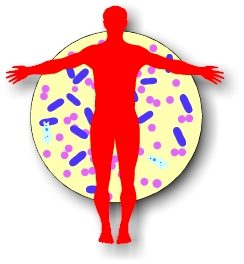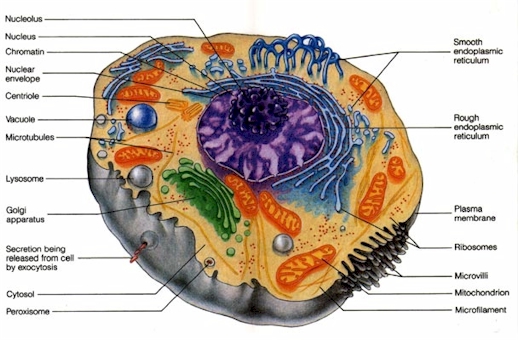


|
The human body is composed of trillions of cells closely functioning together. A cell is also the smallest living unit in the body. |
�H��O�ѼƤQ���Ӻ�K�a�t�X�ۤu�@���ӭM�զ��A�ӭM�]�O�H�餺�̲Ӥp���ͩR���C |

|
Although there are many different kinds of cells in the human body, most of them contain a nucleus, a thick liquid called cytoplasm, and enclosed by a very thin layer of cell membrane. |
���M�H�餺���ܦh�������ӭM�A���j�������]�t�ۤ@���ӭM���]nucleus�^�B�@�ئW�s�ӭM�����]cytoplasm�^���@�p�G��A�åB�Ѥ@�h�������ӭM���]cell membrane�^�]�q�ۡC |
|||||
|
Nucleus The nucleus is the control center of a cell. It contains DNA (deoxyribonucleic acid) molecules, which house the cell's chemical information. A DNA molecule is composed of millions of atoms, structured in a double helix shape. Before a cell divides, its DNA molecules replicate (i.e., copy themselves), to make sure that a complete set of information can be passed to each new cell. |
�ӭM�֡]Nucleus�^ �ӭM���O�@�ӲӭM������ߡA���õ۱a���ӭM���ƾǰT���� DNA�]�h��ֿ}�ֻġ^���l�ADNA �O�@�ӧe�����۪������l�A�ѼƥH�ʸU�p����l�զ��C�@�ӲӭM�b�������e�A�� DNA���l�|���ۨ��ƻs�A�H�T�O��M�T������Q�ǹF�ܨC�@�ӷs���ӭM�C |
|||||
|
The nuclear membrane separates the nucleus from the other components of the cell. However, the nuclear membrane contains numerous holes called nuclear pores, which allow chemical contact between the nucleus and the surroundings. |
�ӭM�ֽ���ӭM�ֻP�ӭM����l�������j�_�ӡA���L�A�ӭM�ֽ��W�s�b�۫ܦh�p�աA�e�\�ӭM�ֻP�~�ɧ@�ƾǤW����IJ�C |
|||||
|
Cytoplasm The cytoplasm is a transparent, jelly-like fluid that contains up to 90% water. It houses the organelles--some structures with special functions inside the cell. The number and types of organelles depend on the functions of the cell. |
�ӭM����]Cytoplasm�^ �ӭM�����O�@�سz���B���������G��A���� 90%�������A�̭��õ��ӭM���]organelles�^�w�w�ӭM���@�Ǩ㦳��S���u����c�C�ӭM�����ƥةM�����h���G�ӲӭM���u��өw�C |
|||||
|
A typical cell usually includes the following organelles: |
�@�Ө嫬���ӭM�q�`�]�A�H�U���ӭM���G |
|||||
|
|
|||||
|
|
|||||
|
|
|||||
|
|
|||||
|
|
|||||
|
Cell Membrane Cell membrane is formed by two layers of phospholipid molecules. They act as a protective shield, allowing some substances to pass through, but preventing the passage of others at the same time. |
�ӭM���]Cell Membrane�^ �ӭM���O�Ѩ�h���C�פ��l�զ��A���Ϧp�@�Ө��@�n�A�e�\�Y�Ǥ��l�i�J���P�ɡA�o����F��L���l���i�J�C |
|
Cell Division |
|
�ӭM���� |
||||
|
|
|
|||||
|
�������� |
|
��Ƥ��� |
||||
|
About 50 millions cells die in a second in the human body. At the same time, they are replaced by the same number of new cells. The life cycle of cells varies from one kind to another. For example, cells lining the skin and the alimentary canal have to experience a lot of wear and tear, and are almost replaced every 24 hours. On the contrary, highly specialized cells such as the neurons (i.e., nerve cells) do not divide at all once they have been formed. |
�H�餺�C�����������d�U�ӲӭM�|���h�A�æP�ɥѥt�~���d�U�ӷs�ͲӭM�Ҩ��N�C�ӭM���ͩR�g��������������P�Ӧ��Ҥ��O�C�Ҧp�A���ֽ������M���ƹD�W���ӭM�A�t���h�C�j�ܥ|�p�ɫK�|�Q�����C���[���Ƿ����M�����ӭM�A�p���g���]���g�ӭM�^�A���o�i������K�|���h�c�ު���O�C |
|||||
|
Cell division is the process by which cells reproduce. There are two types of cell division: mitosis and meiosis. |
�ӭM�����O�ӭM�c�ު��L�{�A�i�z�L��اΦ��i��G���������M��Ƥ����C |
|||||
|
|
|||||
|
|
|||||
|
When cell division becomes uncontrolled, it may lead to growths called tumors, which often spread out rapidly, and even interfere with normal body functioning. Scientists believe that certain carcinogens, accidental rearrangement of DNA molecules in a cell, and virus infection can all be factors that trigger the action of cancers. |
���ӭM�����ܦ��������ɭԡA�N�|�ޭP�~�F���X�{�A�ӥB�q�`�|�ܧ֦a�X�i�}�h�A�v�T��H�骺���`�B�@�C��Ǯa�۫H�@�ǭP������B�ӭM�� DNA ���l�N�~�a���s�ƦC�M�L�o�ʯf�r�P�V���A���|IJ�o���g���o�͡C |
[ ��^
]
Back
�@